Environmental Risk Source Analysis and Classification of Zones: Subway Construction
Abstract
1. Introduction
2. Urumqi Engineering Geological Survey
3. Risk Source Analysis of Subway Construction
3.1. Introduction of SBAS-InSAR
3.2. Geological Conditions
3.3. Super High-Rise Building Distribution
3.4. Road Network Distribution
3.5. Cluster Building Distribution
4. Distribution Characteristics of Environmental Risk Sources of Subway Construction in Study Area
4.1. Spatial Distribution of Geological Conditions
4.2. High-Rise Building Distribution
4.3. Road Network Distribution
4.4. Cluster Building Division
5. Comprehensive Analysis of the Environmental Risk Faced during the Construction of the Subway in the Study Area
5.1. Introduction of Geometric Partition Theory
5.2. Geometric Partition of the Subway Construction Environmental Risk Sources
5.3. Environmental Risk Source Zoning Evaluation and Control of Subway Construction
6. Conclusions
- (1)
- Four main types of risk sources affect the process of Urumqi subway construction, and these can be classified into natural conditions and human engineering activities. Each risk source control level can be divided into geological conditions (I–III) based on their spatial distribution and spatial density distribution. Additionally, the distribution of super high-rise buildings can be classified into levels I–IV, the road network distribution can be classified into levels I–IV, and the cluster building distribution can be classified into levels I–IV.
- (2)
- The environmental risk source area of subway construction in the study area is divided into 103 regions, with 12 areas having an area greater than 250,000 km2. The largest partition number is 1444, and the partition number with the greatest risk is 1112. The environmental risk source and risk level of subway construction in this area are soil layer, grade I super high-rise building risk, grade I road network risk, and grade II building density risk.
- (3)
- We graded the comprehensive impact of risk sources on subway construction according to the distribution of risk sources in each sub-region. We also conducted a statistical analysis of Urumqi Metro Line 1–7 crossing the risk source zones and identified the risk control measures needed when the subway line crosses different risk levels.
- (4)
- In the future planning and construction of the Urumqi subway line, identifying the environmental risk sources of subway construction will assist the planning department in understanding the environmental risk situation surrounding the subway planning line. This information will provide a foundation for the rational planning and adjustment of regional subway lines. The subway construction company will be able to determine the environmental risk level of the subway’s construction and take necessary risk control measures in advance based on the intersection of the actual subway line location and the environmental risk source zoning layer. This will help to mitigate the risk of inconsistency between the judgment results of engineering design drawings and engineering practice due to insufficient consideration of risk factors during the planning and design stage.
Author Contributions
Funding
Institutional Review Board Statement
Informed Consent Statement
Data Availability Statement
Conflicts of Interest
References
- Mohammadi, S.D.; Naseri, F.; Alipoor, S. Development of Artificial Neural Networks and Multiple Regression Models for the NATM Tunnelling-Induced Settlement in Niayesh Subway Tunnel, Tehran. Bull. Eng. Geol. Environ. 2015, 74, 827–843. [Google Scholar] [CrossRef]
- Cui, Z.-D.; Tan, J. Analysis of Long-Term Settlements of Shanghai Subway Line 1 Based on the in Situ Monitoring Data. Nat. Hazards 2015, 75, 465–472. [Google Scholar] [CrossRef]
- Zhang, Q.; Wang, J.; Zhang, H. Attribute Recognition Model and Its Application of Risk Assessment for Slope Stability at Tunnel Portal. J. Vibroeng. 2017, 19, 2726–2738. [Google Scholar] [CrossRef]
- Yu, J.; Zhong, D.; Ren, B.; Tong, D.; Hong, K. Probabilistic Risk Analysis of Diversion Tunnel Construction Simulation. Comput.-Aided Civ. Infrastruct. Eng. 2017, 32, 748–771. [Google Scholar] [CrossRef]
- Zhou, Z.; Li, Q.; Wu, W. Developing a Versatile Subway Construction Incident Database for Safety Management. J. Constr. Eng. Manag.-Asce 2012, 138, 1169–1180. [Google Scholar] [CrossRef]
- Liu, J.; Du, Z.; Ma, L.; Liu, C. Identification and Assessment of Subway Construction Risk: An Integration of AHP and Experts Grading Method. Adv. Civ. Eng. 2021, 2021, 6661099. [Google Scholar] [CrossRef]
- Fu, L.; Wang, X.; Zhao, H.; Li, M. Interactions among Safety Risks in Metro Deep Foundation Pit Projects: An Association Rule Mining-Based Modeling Framework. Reliab. Eng. Syst. Saf. 2022, 221, 108381. [Google Scholar] [CrossRef]
- Sun, C. Research on Safety Risk Control Technology and Its Application in Beijing Metro Approaching Construction; Beijing Jiaotong University: Beijing, China, 2014. (In Chinese) [Google Scholar]
- Stirbys, A.F.; Radwanski, Z.R.; Proctor, R.J.; Escandon, R.F. Los Angeles Metro Rail Project–Geologic and Geotechnical Design and Construction Constraints. Eng. Geol. 1999, 51, 203–224. [Google Scholar] [CrossRef]
- Li, S. Study on Risk Management of Subway Construction to Surroundings Environment; Xi’an University Architecture and Technology: Xi’an, China, 2011. (In Chinese) [Google Scholar]
- Han, M.; Li, Z.; Mei, G.; Bao, X.; Jia, J.; Liu, L.; Li, Y. Characteristics of Subway Excavation in Soft Soil and Protective Effects of Partition Wall on the Historical Building and Pile Foundation Building. Bull. Eng. Geol. Environ. 2022, 81, 307. [Google Scholar] [CrossRef]
- Xiao, Y. Study on the Impact of High-Rise Building on the Safety of Subway Station; Chongqing Jiaotong University: Chongqing, China, 2017. (In Chinese) [Google Scholar]
- Shen, Z. Impact of the Super High-Rise Building Constructing and Using Stage on Closely Adjacent Operating Metro Tunnels; Beijing Jiaotong University: Beijing, China, 2017. (In Chinese) [Google Scholar]
- Xue, Y.; Li, X.; Li, G.; Qiu, D.; Gong, H.; Kong, F. An Analytical Model for Assessing Soft Rock Tunnel Collapse Risk and Its Engineering Application. Geomech. Eng. 2020, 23, 441–454. [Google Scholar] [CrossRef]
- Xu, Z.; Cai, N.; Li, X.; Xian, M.; Dong, T. Risk Assessment of Loess Tunnel Collapse during Construction Based on an Attribute Recognition Model. Bull. Eng. Geol. Environ. 2021, 80, 6205–6220. [Google Scholar] [CrossRef]
- Meng, G.; Ye, Y.; Wu, B.; Luo, G.; Zhang, X.; Zhou, Z.; Sun, W. Risk Assessment of Shield Tunnel Construction in Karst Strata Based on Fuzzy Analytic Hierarchy Process and Cloud Model. Shock Vib. 2021, 2021, 7237136. [Google Scholar] [CrossRef]
- Zhou, Y.; Liu, Y.; Chen, Q.; Ou, X.; Li, Y. Case Study of an Underpinning Pile Foundation for an Interval Tunnel Crossing an Existing Bridge. Appl. Sci. 2022, 12, 12566. [Google Scholar] [CrossRef]
- Li, C.; Zhang, W.; Wang, X.; Pan, B.; Zhu, H.; Spencer, B.F. Modeling Dynamic Responses of a Cross-River Road Shield Tunnel under Stochastic Vehicle Loads. Tunn. Undergr. Space Technol. 2020, 102, 103432. [Google Scholar] [CrossRef]
- Jun, S.; Jun, L.; Yong, W. Analysis of the influence of subway entrance excavation on tunnel and adjacent buildings. IOP Conf. Series. Earth Environ. Sci. 2019, 371, 022037. [Google Scholar]
- Xu, Z.; Li, X. Analysis of Settlement Caused by Tunnel Underneath Existing Railway after Construction. Adv. Mater. Res. 2013, 2592, 534. [Google Scholar] [CrossRef]
- Luo, C.; Cheng, Y.; Bai, Z.; Shen, T.; Wu, X.-Y.; Wang, Q. Study on Settlement and Deformation of Urban Viaduct Caused by Subway Station Construction under Complicated Conditions. Adv. Civ. Eng. 2021, 2021, 6625429. [Google Scholar] [CrossRef]
- Ren, D.-J.; Shen, S.-L.; Cheng, W.-C.; Zhang, N.; Wang, Z.-F. Geological Formation and Geo-Hazards during Subway Construction in Guangzhou. Environ. Earth Sci. 2016, 75, 934. [Google Scholar] [CrossRef]
- Jin, D.; Yuan, D.; Li, X.; Zheng, H. Analysis of the Settlement of an Existing Tunnel Induced by Shield Tunneling Underneath. Tunn. Undergr. Space Technol. 2018, 81, 209–220. [Google Scholar] [CrossRef]
- Gan, X.; Yu, J.; Gong, X.; Zhu, M. Characteristics and Countermeasures of Tunnel Heave Due to Large-Diameter Shield Tunneling Underneath. J. Perform. Constr. Facil. 2020, 34, 04019081. [Google Scholar] [CrossRef]
- Ng, C.W.W.; Boonyarak, T.; Masin, D. Effects of Pillar Depth and Shielding on the Interaction of Crossing Multitunnels. J. Geotech. Geoenviron. Eng. 2015, 141, 04015021. [Google Scholar] [CrossRef]
- Lai, H.; Zheng, H.; Chen, R.; Kang, Z.; Liu, Y. Settlement Behaviors of Existing Tunnel Caused by Obliquely Under-Crossing Shield Tunneling in Close Proximity with Small Intersection Angle. Tunn. Undergr. Space Technol. 2020, 97, 103258. [Google Scholar] [CrossRef]
- Merlini, D.; Stocker, D.; Falanesca, M.; Schuerch, R. The Ceneri Base Tunnel: Construction Experience with the Southern Portion of the Flat Railway Line Crossing the Swiss Alps. Engineering 2018, 4, 235–248. [Google Scholar] [CrossRef]
- Lian, X.; Wu, Y.; Ge, L.; Du, Z.; Liu, X. DInSAR Monitoring of Surface Subsidence by Fusing Sentinel-1A and-1B Data to Improve Time Resolution in a Mining Area. Can. J. Remote Sens. 2021, 47, 596–606. [Google Scholar] [CrossRef]
- Xie, Z.; Chen, G.; Meng, X.; Zhang, Y.; Qiao, L.; Tan, L. A Comparative Study of Landslide Susceptibility Mapping Using Weight of Evidence, Logistic Regression and Support Vector Machine and Evaluated by SBAS-InSAR Monitoring: Zhouqu to Wudu Segment in Bailong River Basin, China. Environ. Earth Sci. 2017, 76, 313. [Google Scholar] [CrossRef]
- Li, Y.; Yang, K.; Zhang, J.; Hou, Z.; Wang, S.; Ding, X. Research on Time Series InSAR Monitoring Method for Multiple Types of Surface Deformation in Mining Area. Nat. Hazards 2022, 114, 2479–2508. [Google Scholar] [CrossRef]
- Du, Y.; Feng, G.; Peng, X.; Li, Z. Subsidence Evolution of the Leizhou Peninsula, China, Based on InSAR Observation from 1992 to 2010. Appl. Sci. 2017, 7, 466. [Google Scholar] [CrossRef]
- Tao, Q.; Wang, F.; Guo, Z.; Hu, L.; Yang, C.; Liu, T. Accuracy Verification and Evaluation of Small Baseline Subset (SBAS) Interferometric Synthetic Aperture Radar (InSAR) for Monitoring Mining Subsidence. Eur. J. Remote Sens. 2021, 54, 641–662. [Google Scholar] [CrossRef]
- Wang, H.; Feng, G.; Xu, B.; Yu, Y.; Li, Z.; Du, Y.; Zhu, J. Deriving Spatio-Temporal Development of Ground Subsidence Due to Subway Construction and Operation in Delta Regions with PS-InSAR Data: A Case Study in Guangzhou, China. Remote Sens. 2017, 9, 1004. [Google Scholar] [CrossRef]
- Zhao, Y.; Zhou, L.; Wang, C.; Li, J.; Qin, J.; Sheng, H.; Huang, L.; Li, X. Analysis of the Spatial and Temporal Evolution of Land Subsidence in Wuhan, China from 2017 to 2021. Remote Sens. 2022, 14, 3142. [Google Scholar] [CrossRef]
- Zhang, Y.; Liu, Y.; Jin, M.; Jing, Y.; Liu, Y.; Liu, Y.; Sun, W.; Wei, J.; Chen, Y. Monitoring Land Subsidence in Wuhan City (China) Using the SBAS-InSAR Method with Radarsat-2 Imagery Data. Sensors 2019, 19, 743. [Google Scholar] [CrossRef]
- Shi, W.; Chen, G.; Meng, X.; Jiang, W.; Chong, Y.; Zhang, Y.; Dong, Y.; Zhang, M. Spatial-Temporal Evolution of Land Subsidence and Rebound over Xi’an in Western China Revealed by SBAS-InSAR Analysis. Remote Sens. 2020, 12, 3756. [Google Scholar] [CrossRef]
- Xiao, B.; Zhao, J.; Li, D.; Zhao, Z.; Xi, W.; Zhou, D. The Monitoring and Analysis of Land Subsidence in Kunming (China) Supported by Time Series InSAR. Sustainability 2022, 14, 12387. [Google Scholar] [CrossRef]
- Hu, B.; Yang, B.; Zhang, X.; Chen, X.; Wu, Y. Time-Series Displacement of Land Subsidence in Fuzhou Downtown, Monitored by SBAS-InSAR Technique. J. Sens. 2019, 2019, 3162652. [Google Scholar] [CrossRef]
- Hussain, M.A.; Chen, Z.; Shoaib, M.; Shah, S.U.; Khan, J.; Ying, Z. Sentinel-1A for Monitoring Land Subsidence of Coastal City of Pakistan Using Persistent Scatterers In-SAR Technique. Sci. Rep. 2022, 12, 5294. [Google Scholar] [CrossRef]
- Hu, B.; Chen, B.; Na, J.; Yao, J.; Zhang, Z.; Du, X. Urban Surface Deformation Management: Assessing Dangerous Subsidence Areas through Regional Surface Deformation, Natural Factors, and Human Activities. Sustainability 2022, 14, 10487. [Google Scholar] [CrossRef]
- Li, Y.; Jin, X.; Feng, Y.; Luo, W. Effect of Soft Layer on Seismic Response of Subway Station in Layered Stratum. J. Vibroeng. 2016, 18, 1602–1616. [Google Scholar] [CrossRef]
- Luo, J.; Miao, L. Research on Dynamic Creep Strain and Settlement Prediction under the Subway Vibration Loading. SpringerPlus 2016, 5, 1252. [Google Scholar] [CrossRef]
- Jiang, X.; Hou, L.; Shang, S.; Xu, L.; Yu, H. Physical Modeling of a Shallow-Buried Metro Tunnel in the Soft Loess Layer Using Similarity Theory. Adv. Civ. Eng. 2022, 2022, 5587116. [Google Scholar] [CrossRef]
- Feng, X.; Hou, D.; Huang, Z. The Influence of Shield Tunneling Characteristics on the Safety of Buildings Above-Case Study for Shanghai Zone. Sustainability 2022, 14, 13391. [Google Scholar] [CrossRef]
- Liu, J.; Qi, T.; Wu, Z. Analysis of Ground Movement Due to Metro Station Driven with Enlarging Shield Tunnels under Building and Its Parameter Sensitivity Analysis. Tunn. Undergr. Space Technol. 2012, 28, 287–296. [Google Scholar] [CrossRef]
- Li, M.; Zhang, X.; Bai, Z.; Xie, H.; Chen, B. Land Subsidence in Qingdao, China, from 2017 to 2020 Based on PS-InSAR. Int. J. Environ. Res. Public. Health 2022, 19, 4913. [Google Scholar] [CrossRef] [PubMed]
- Yu-Geng, T.; Tung-Chin, K.G. Probability Based Analysis of Excavation-Induced Damage Potential of Buildings Using a Simplified Evaluation Model. Disaster Adv. 2012, 5, 332–340. [Google Scholar]
- Yuan, C.; Liu, Y.; Li, C.; Wang, C. Analysis of Settlement Characteristics of an Ultrahigh-Rise Building in the Construction Process. Sci. Surv. Mapp. 2017, 42, 172–177. [Google Scholar]
- Ministry of Construction of the People’s Republic of China. Code for Design of Civil Buildings-GB50352–2005; Ministry of Construction of the People’s Republic of China: Beijing, China, 2005. (In Chinese)
- Usui, H.; Asami, Y. Size Distribution of Building Lots and Density of Buildings and Road Networks: Theoretical Derivation Based on Gibrat’s Law and Empirical Study of Downtown Districts in Tokyo. Int. Reg. Sci. Rev. 2020, 43, 229–253. [Google Scholar] [CrossRef]
- Song, Y.; Chen, X.; Zou, B.; Mu, J.; Hu, R.; Cheng, S.; Zhao, S. Monitoring Study of Long-Term Land Subsidence during Subway Operation in High-Density Urban Areas Based on DInSAR-GPS-GIS Technology and Numerical Simulation. Cmes-Comput. Model. Eng. Sci. 2023, 134, 1021–1039. [Google Scholar] [CrossRef]
- Zhao, Y.; Liu, C. The Role of Load of Clustered Architecture on Land Subsidence. Hydrogeol. Eng. Geol. 2016, 43, 162–170. (In Chinese) [Google Scholar]
- Li, L.; Zheng, X.; Xiang, W. A Study on Site Coverage Spatial Distribution Pattern of Beijing City Based on Gis. China Popul. Environ. 2008, 18, 122–127. (In Chinese) [Google Scholar]
- Xie, L. Reverse Slope’ Toppling Deformation Characteristics Based on Geological Geometric Partitioning. Sci. Technol. Eng. 2018, 18, 32–37. (In Chinese) [Google Scholar]
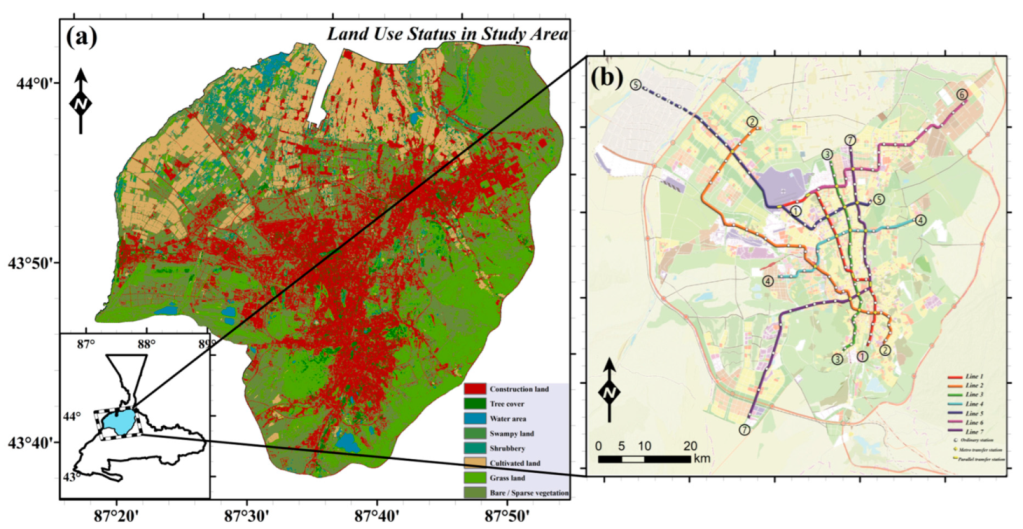

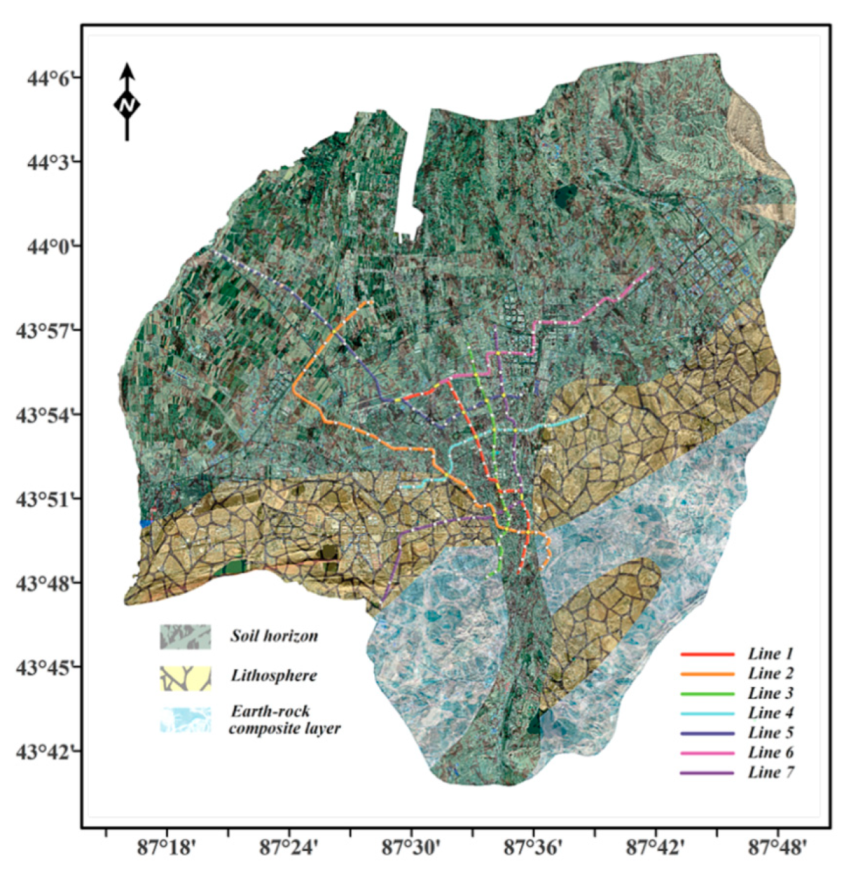
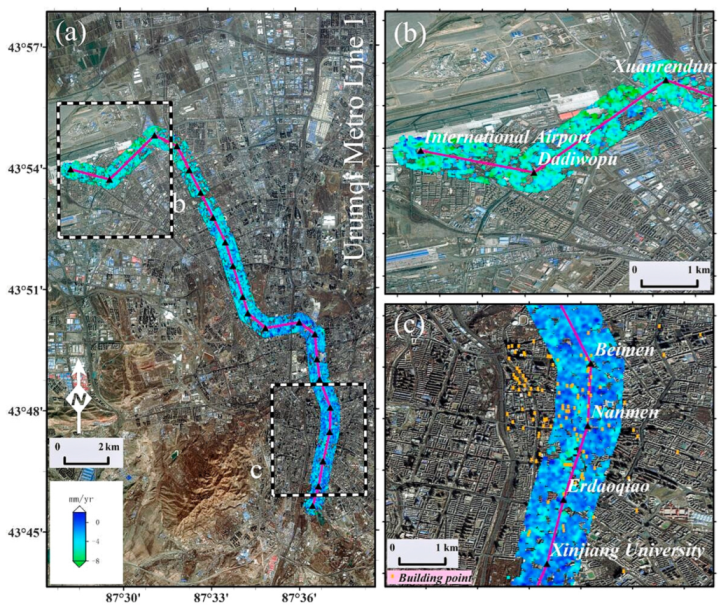
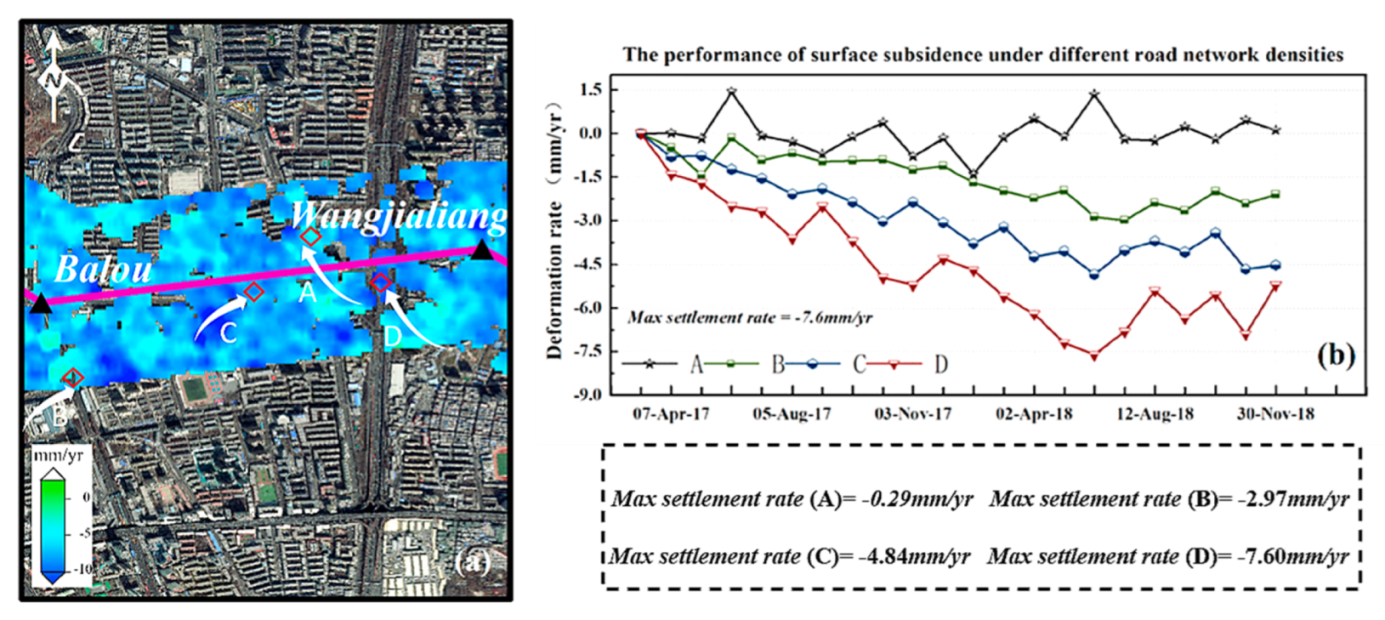
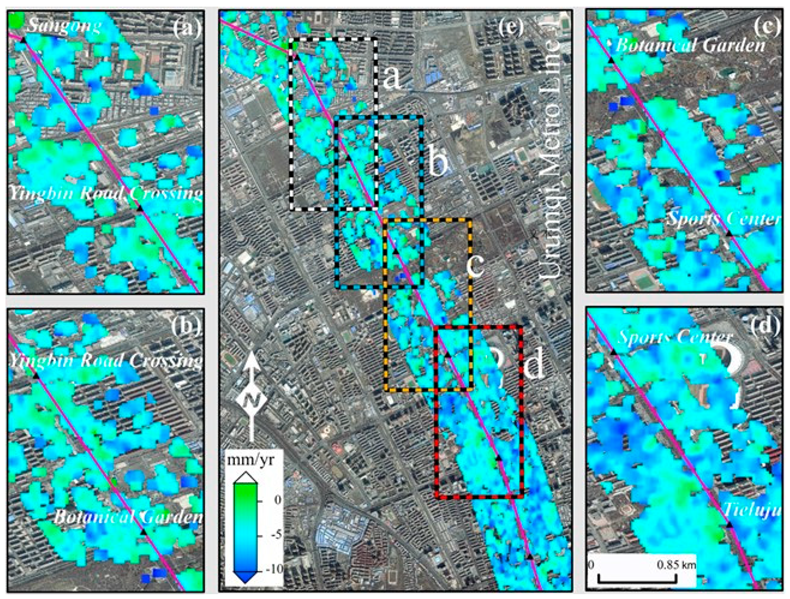
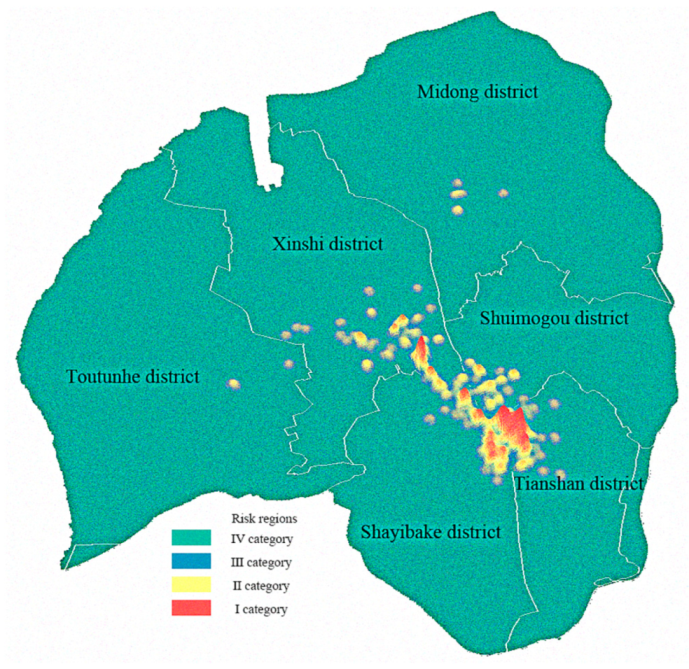
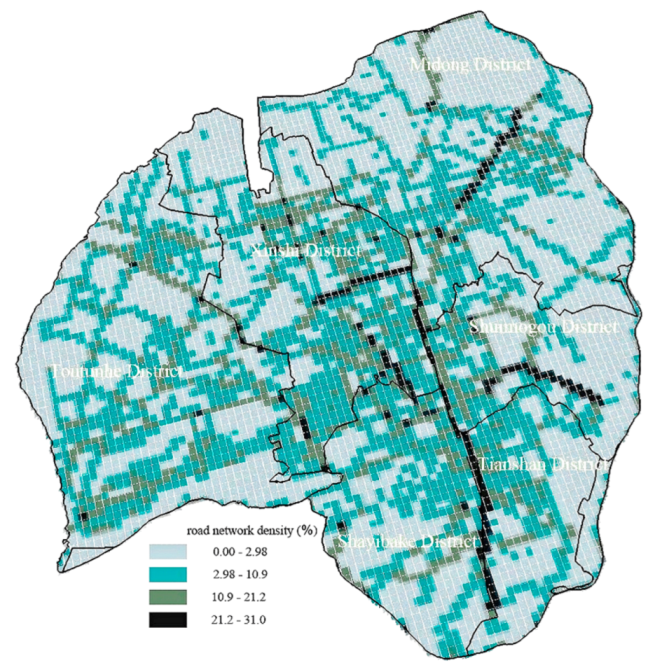
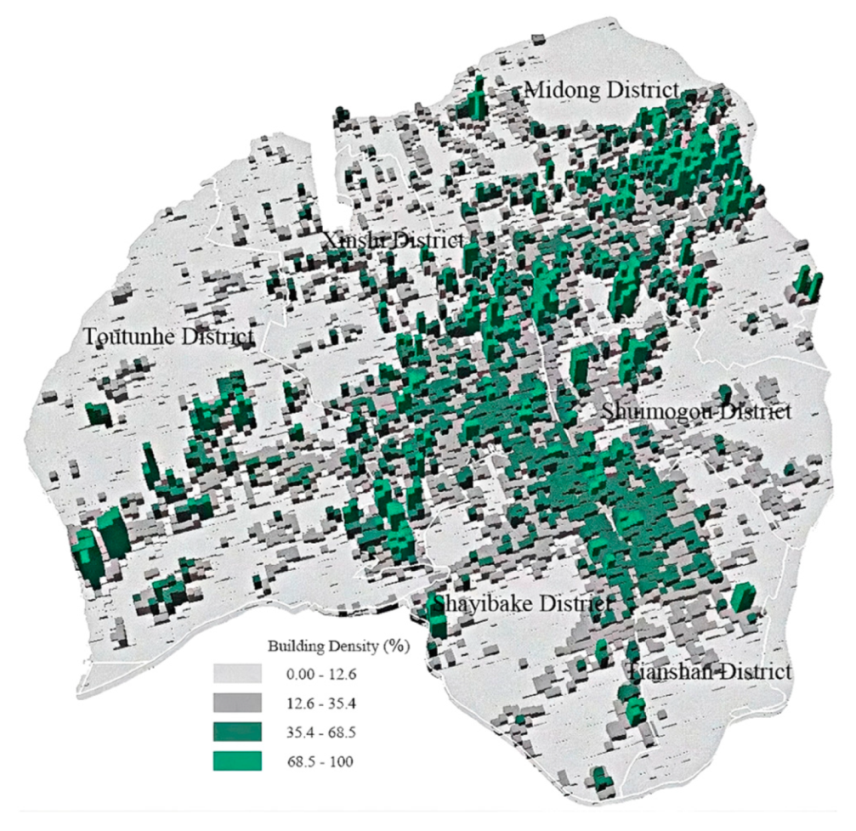

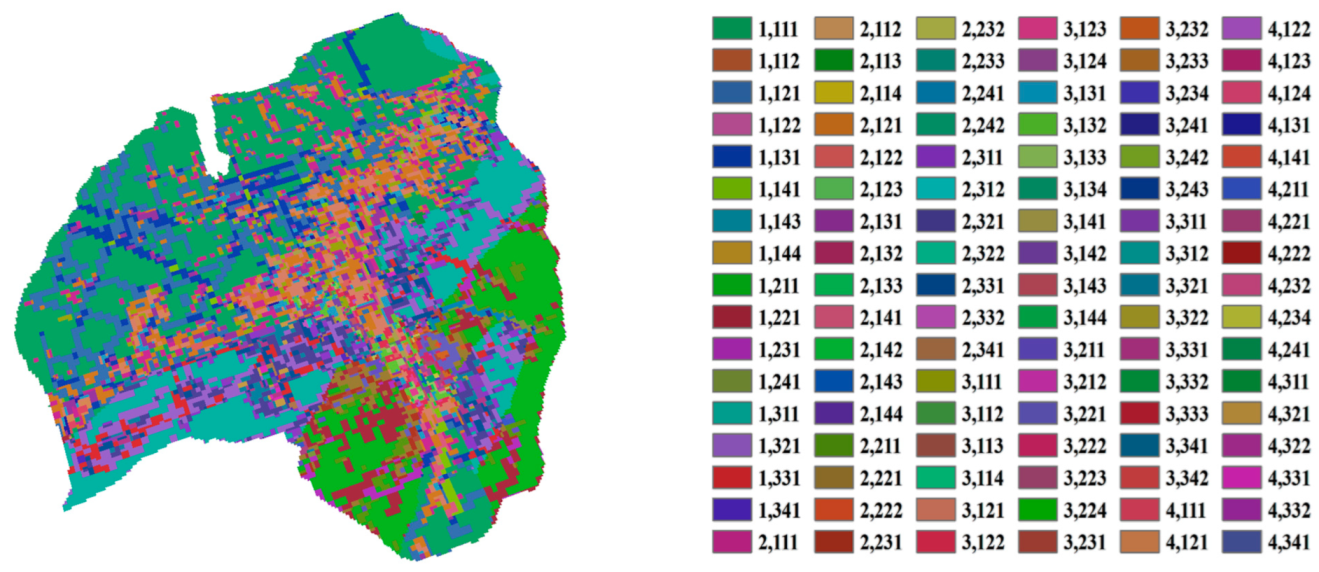

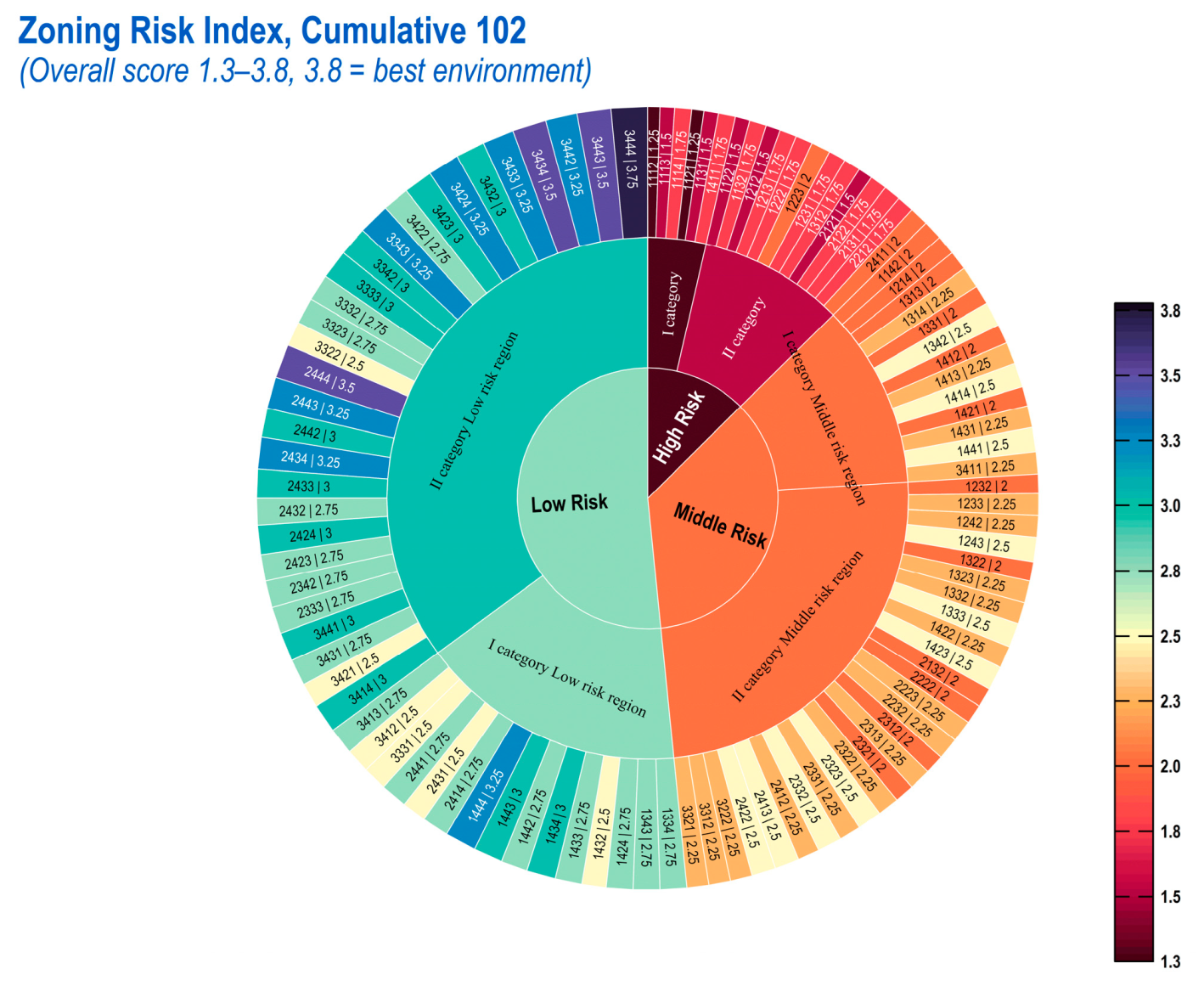
| Data | 2 | 0 | −2 | −4 | −6 | −8 | −10 | −12 | Environment Variable | ||||
|---|---|---|---|---|---|---|---|---|---|---|---|---|---|
| Area | Building Density (%) | Super High-Rise Building | Geological Condition | ||||||||||
| a |  | 23.7 |  | None | soil horizon | ||||||||
| b | 28.9 | None | soil horizon | ||||||||||
| c | 32.6 | None | soil horizon | ||||||||||
| d | 48.2 | None | soil horizon | ||||||||||
| Geological Conditions Risk Level | Geological Condition | Area (km2) | Proportion (%) |
|---|---|---|---|
| Level I | Soil horizon | 1771.3 | 63 |
| Level II | Earth-rock composite layer | 429.1 | 15.3 |
| Level III | Lithosphere | 612.6 | 21.7 |
| High-Rise Building Risk Level | The Influence Range of Nuclear Density | Influence Area (km2) |
|---|---|---|
| Level I | 0.00–13.43 | 2779.28 |
| Level II | 13.43–26.87 | 24.92 |
| Level III | 26.87–40.31 | 6.96 |
| Level IV | 40.31–53.75 | 1.84 |
| Road Network Density Risk Level | Density Range (%) | Proportion (%) |
|---|---|---|
| Level I | 0.00–2.98 | 3.0 |
| Level II | 2.98–10.9 | 7.9 |
| Level III | 10.9–21.2 | 34.6 |
| Level IV | 21.2–31.0 | 54.5 |
| Building Density Risk Level | Density Range (%) | Proportion (%) |
|---|---|---|
| Level I | 68.5–100 | 2.5 |
| Level II | 35.4–68.5 | 14.8 |
| Level III | 12.6–35.4 | 27.6 |
| Level IV | 0.00–12.6 | 55.1 |
| Type | Geological Condition | High-Rise Building Risk | Building Density Risk | Road Network Density Risk |
|---|---|---|---|---|
| Level 1 | Soil horizon | I | I | I |
| Level 2 | Rock layer | II | II | II |
| Level 3 | Earth-rock composite layer | III | III | III |
| Level 4 | IV | IV | IV | |
| Partition number | Kilobit | hundred’s place | ten’s place | units |
| Metro Lines | Main Crossing Partition | Risk Index | The Highest Level of Risk Zoning | Regional Number | Risk Index |
|---|---|---|---|---|---|
| Line 1 | 1432 | 2.25 | 1113 | 1 | 1.5 |
| Line 2 | 3433 | 3.25 | 1312 | 2 | 1.75 |
| Line 3 | 2433 | 3 | 1122 | 2 | 1.5 |
| Line 4 | 3424 | 3.25 | 1312 | 1 | 1.75 |
| Line 5 | 1444 | 3.25 | 1232 | 1 | 2 |
| Line 6 | 1433 | 2.75 | 1212 | 5 | 1.5 |
| Line 7 | 3444 | 3.75 | 1222 | 3 | 1.75 |
| Zoning Risk Level | Risk Index Interval | Explanation |
|---|---|---|
| I category high-risk region | [1.25, 1.75) | Preventive measures must be implemented for various risk sources. The settlement performance of the area must be strictly monitored during construction. |
| II category high-risk region | Preventive measures must be implemented for each level I risk source. | |
| I category middle-risk region | [1.75, 2.50) | Preventive measures should be identified and implemented for each level I risk source to reduce risk levels |
| II category middle-risk region | ||
| I category low-risk region | [2.50, 3.75) | The risk is on the edge of tolerance, and it is necessary to pay attention to the possible impact of each level of risk source |
| II category low-risk region | The risk can be tolerated without taking preventive measures |
Disclaimer/Publisher’s Note: The statements, opinions and data contained in all publications are solely those of the individual author(s) and contributor(s) and not of MDPI and/or the editor(s). MDPI and/or the editor(s) disclaim responsibility for any injury to people or property resulting from any ideas, methods, instructions or products referred to in the content. |
© 2023 by the authors. Licensee MDPI, Basel, Switzerland. This article is an open access article distributed under the terms and conditions of the Creative Commons Attribution (CC BY) license (https://creativecommons.org/licenses/by/4.0/).
Share and Cite
Yuan, Y.; Qin, Y.; Zhang, Y.; Xie, L.; Meng, X.; Guo, Z. Environmental Risk Source Analysis and Classification of Zones: Subway Construction. Appl. Sci. 2023, 13, 5831. https://doi.org/10.3390/app13105831
Yuan Y, Qin Y, Zhang Y, Xie L, Meng X, Guo Z. Environmental Risk Source Analysis and Classification of Zones: Subway Construction. Applied Sciences. 2023; 13(10):5831. https://doi.org/10.3390/app13105831
Chicago/Turabian StyleYuan, Yangchun, Yongjun Qin, Yongkang Zhang, Liangfu Xie, Xin Meng, and Zheyi Guo. 2023. "Environmental Risk Source Analysis and Classification of Zones: Subway Construction" Applied Sciences 13, no. 10: 5831. https://doi.org/10.3390/app13105831
APA StyleYuan, Y., Qin, Y., Zhang, Y., Xie, L., Meng, X., & Guo, Z. (2023). Environmental Risk Source Analysis and Classification of Zones: Subway Construction. Applied Sciences, 13(10), 5831. https://doi.org/10.3390/app13105831






